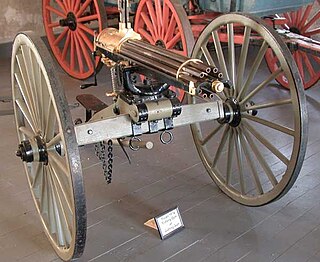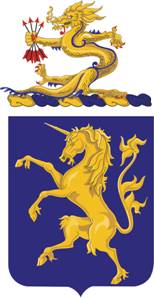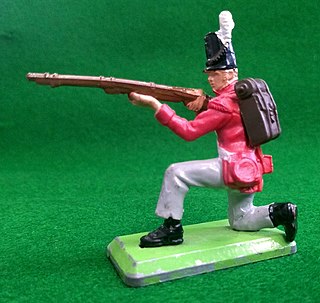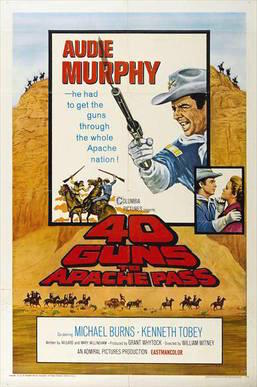
The Gatling gun is a rapid-firing multiple-barrel firearm invented in 1861 by Richard Jordan Gatling. It is an early machine gun and a forerunner of the modern electric motor-driven rotary cannon.

The Battle of the Little Bighorn, known to the Lakota and other Plains Indians as the Battle of the Greasy Grass, and commonly referred to as Custer's Last Stand, was an armed engagement between combined forces of the Lakota Sioux, Northern Cheyenne, and Arapaho tribes and the 7th Cavalry Regiment of the United States Army. It took place on June 25–26, 1876, along the Little Bighorn River in the Crow Indian Reservation in southeastern Montana Territory. The battle, which resulted in the defeat of U.S. forces, was the most significant action of the Great Sioux War of 1876.

The Battle of San Juan Hill, also known as the Battle for the San Juan Heights, was a major battle of the Spanish–American War fought between an American force under the command of William Rufus Shafter and Joseph Wheeler against a Spanish force led by Arsenio Linares y Pombo. The combined assaults on Kettle Hill and San Juan Hill that together form San Juan Heights proved to be one of the most significant battles of the war and, along with the Siege of Santiago, a decisive battle in deciding the fate of the United States Army campaign in Cuba. The American forces, outnumbering the Spanish defenders 16-to-one, charged upon the heights and dispersed the Spanish after suffering heavy casualties.

Something Big is a 1971 American Western comedy film directed by Andrew V. McLaglen. Produced by McLaglen and screenwriter James Lee Barrett, the film stars Dean Martin, Honor Blackman and Brian Keith.

Rio Grande is a 1950 American romantic Western film directed by John Ford and starring John Wayne and Maureen O'Hara. It is the third installment of Ford's "Cavalry Trilogy", following two RKO Pictures releases: Fort Apache (1948) and She Wore a Yellow Ribbon (1949). Wayne plays the lead in all three films, as Captain Kirby York in Fort Apache, then as Captain Nathan Brittles in She Wore a Yellow Ribbon, and finally as a promoted Lieutenant Colonel Kirby Yorke in Rio Grande. Rio Grande's supporting cast features Ben Johnson, Claude Jarman Jr., Harry Carey Jr., Chill Wills, J. Carrol Naish, Victor McLaglen, Grant Withers, the Western singing group the Sons of the Pioneers and Stan Jones.

Posse is a 1993 American Western film directed by and starring Mario Van Peebles. Featuring a large ensemble cast, the film tells the story of a posse of African-American soldiers and one ostracized white soldier, who are all betrayed by a corrupt colonel. The story starts with the group escaping with a cache of gold, and continues with their leader Jesse Lee taking revenge on the men who killed his preacher father. The story is presented as a flashback told by an unnamed old man. The title of the film refers to a group of people who are summoned to help law enforcement officers. This film was the first film to be released by Gramercy Pictures.

The 2nd Cavalry Regiment, also known as the Second Dragoons, is an active Stryker infantry and cavalry regiment of the United States Army. The Second Cavalry Regiment is a unit of the United States Army Europe and Africa, with its garrison at the Rose Barracks in Vilseck, Germany. It can trace its lineage back to the early part of the 19th century.

Woodrow Wilson Woolwine Strode was an American athlete, actor, and author. He was a decathlete and football star who was one of the first Black American players in the National Football League (NFL) in the postwar era. After football, he went on to become a film actor, where he was nominated for a Golden Globe Award for Best Supporting Actor for his role in Spartacus in 1960. Strode also served in the United States Army Air Corps during World War II.

Major Dundee is a 1965 American Western film directed by Sam Peckinpah and starring Charlton Heston, Richard Harris, Jim Hutton, and James Coburn. Written by Harry Julian Fink, the film is about a Union cavalry officer who leads a contentious troop of Army regulars, Confederate prisoners, and Indian scouts on an expedition into Mexico during the American Civil War to destroy a band of Apaches who have been raiding United States bases and settlements in the New Mexico territory. Major Dundee was filmed in various locations in Mexico. The movie was filmed in Eastman Color by Pathécolor, print by Technicolor.

The 3rd Cavalry Regiment, formerly 3rd Armored Cavalry Regiment is a regiment of the United States Army currently stationed at Fort Cavazos, Texas.

Fort Apache is a 1948 American Western film directed by John Ford and starring John Wayne and Henry Fonda. The film was the first of the director's "Cavalry Trilogy" and was followed by She Wore a Yellow Ribbon (1949) and Rio Grande (1950), both also starring Wayne. The screenplay was inspired by James Warner Bellah's short story "Massacre" (1947). The historical sources for "Massacre" have been attributed both to George Armstrong Custer and the Battle of Little Bighorn and to the Fetterman Fight.

The 5th Cavalry Regiment is a historical unit of the United States Army that began its service on March 3, 1855 as the Second Cavalry Regiment. On August 3, 1861, it was redesignated as the 5th Cavalry Regiment following an act of Congress directing "that the two regiments of dragoons, the regiment of mounted riflemen, and the two regiments of cavalry shall hereafter be known and recognized, as the first, second, third, fourth, and fifth regiments of cavalry respectively..." and continues in modified organizational format in the U.S. Army.

Hondo is a 1953 Warnercolor 3D Western film directed by John Farrow and starring John Wayne and Geraldine Page. The screenplay is based on the 1952 Collier's short story "The Gift of Cochise" by Louis L'Amour. The book Hondo was a novelization of the film also written by L'Amour, and published by Gold Medal Books in 1953. The supporting cast features Ward Bond, James Arness and Leo Gordon.

The 6th Cavalry is a regiment of the United States Army that began as a regiment of cavalry in the American Civil War. It currently is organized into aviation squadrons that are assigned to several different combat aviation brigades.

Rio Conchos is a 1964 American Cinemascope Western film directed by Gordon Douglas and starring Richard Boone, Stuart Whitman, Anthony Franciosa, Edmond O'Brien, and in his motion picture debut, Jim Brown, based on Clair Huffaker's novel "Guns of Rio Conchos" published in 1958.

Britains' Deetail toy soldiers were a popular product in the 1970s and 1980s. Manufactured in England by W. Britain, the 1/32 (54mm) scale plastic figures were finished with hand painted details and came with sturdy Zamak metal bases. In the early 1990s production moved to China before eventually being phased out.

The Deserter, also known as The S.O.B.s and The Devil's Backbone is a 1970 Italian-Yugoslav American international co-production Western film produced by Dino De Laurentiis. It was directed by Burt Kennedy and written by Clair Huffaker.

Only the Valiant, also known as Fort Invincible, is a 1951 American Western film produced by William Cagney, directed by Gordon Douglas and starring Gregory Peck, Barbara Payton, and Ward Bond. The screenplay was written by Edmund H. North and Harry Brown, based on the 1943 novel of the same name by Charles Marquis Warren.

40 Guns to Apache Pass is a 1967 American Western film directed by William Witney and starring Audie Murphy.



















